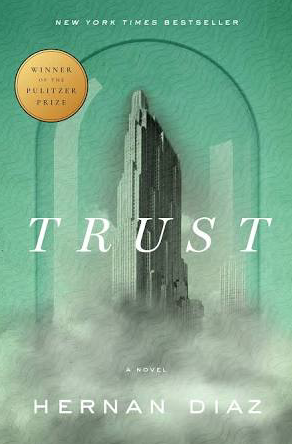
Trust is Hernan Diaz’s second novel and recently won the Pulitzer Prize for fiction. It tells the story of a New York financier and his wife in the 1920’s from three points of view – through a novel of the time, in the financier’s own autobiography and from the perspective of the secretary hired to transcribe his life stories. This trilogy of viewpoints serves to ask how truth can really be determined, and shows how even nonfiction might have an unreliable narrator.
Without spoiling plot, I can say that the structural device of presenting fictional fiction and fictional non-fiction at first made me worry I was going to be overwhelmed with simply navigating the action, but that was not a problem, and the story itself was clear and engaging (other than some financial specifics that were easy enough to gloss over as literary set-dressing). In fact, it wasn’t until the second section that I started to realize what was happening, and how the plot was not really the story at all, but rather an example of what the real narrative of Trust is about – a realization that truth and fiction often overlap, sometimes intentionally, and are subject to the voice in control.
By the end of the third section, my experience had changed again, and another perspective was introduced, which was to consider the narrative from the point of view of those who were not telling it, those whose voice had been represented by others but never by themselves. Again, it brought around the idea that, similar to how history is written by the victor, any writing, be it fiction or biography, is still written by an author, and any character within is seen only through that author’s limited and partisan eyes.
This book was an impressive accomplishment of using fiction-within-fiction to tell a story about perspective, social expectations and the nature of truth. Within this tight and clean structure, it also created a clear picture of the world of high finance and the uber-wealthy of the early 20th century. I was struck by this passage, depicting the inside of the financier’s home:
She was touched by the smaller things. A doorknob. An unassuming chair in a dusky recess. A sofa and the void around it. They all reached out to her with their heightened presence. These were all common-enough objects, but they were the real things, the originals after which the flawed copies that littered the world had been made. (51-52)
And beyond both content and construction, even as a novel itself, Trust leaves me thinking about all the history we’ve been taught, and all the potential history we have not, and whether or not we will ever know the reality of either.